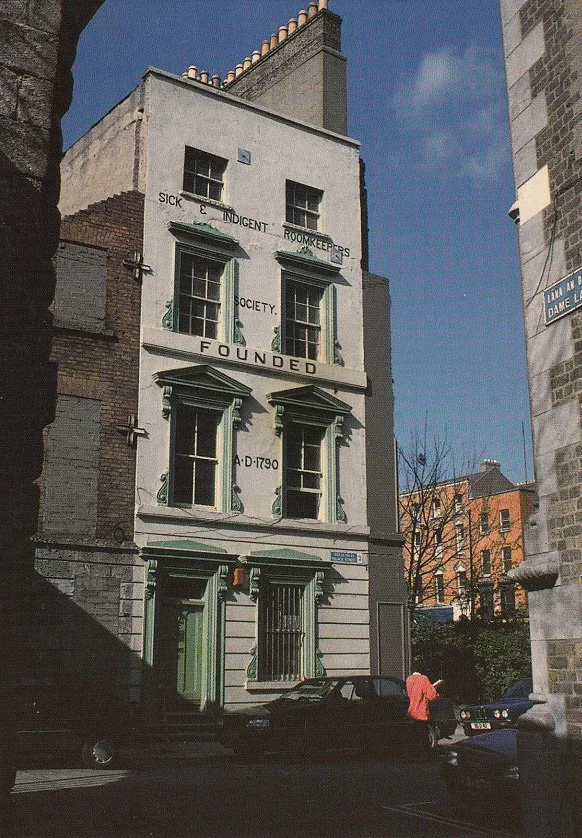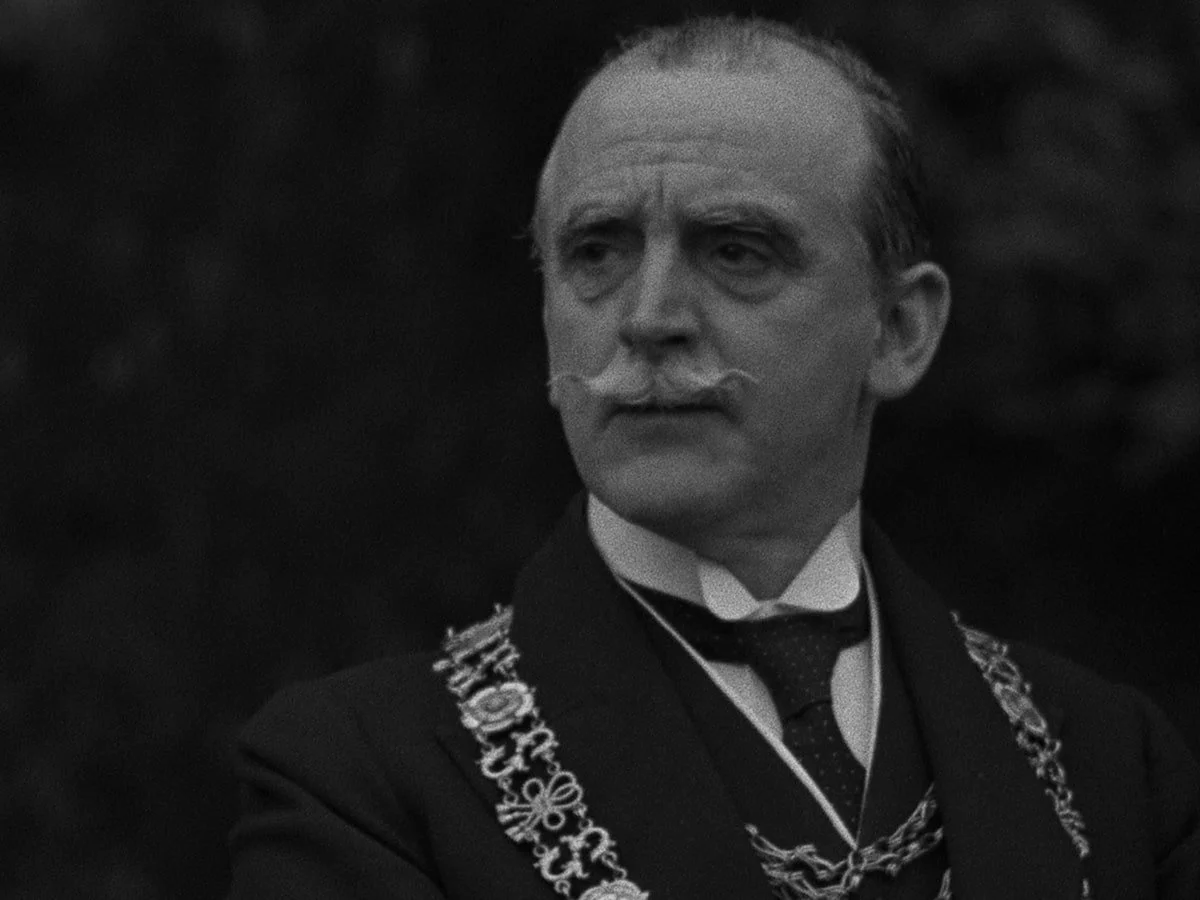History
Founded in 1790, Dublin’s oldest surviving charity.
The Sick and Indigent Roomkeepers Society has given over 230 years of service to Dublin's poor and the sick.
As recorded in the History of the City of Dublin, by Warburton, Whitelaw & Walsh (London, 1818), the Society was founded by “a few individuals in the middle ranks of life [who], inhabiting a part of the town where the population was poor and crowded, had daily opportunities of knowing that many poor creatures who were unable to dig and ashamed to beg expired of want and were often found dead in the sequestrated garrets and cellars to which they had silently returned”. The part of Dublin referred to was the area of Charles Street West behind Ormond Quay, in the parish of St Michan.
Samuel Rosborough (1757 -1832), a founder of the Sick and Indigent Roomkeepers Society 1790.
15 March 1790 at the inaugural meeting the founders Samuel Rosborough, Laurence Toole and nine others, resolved to form a society ”to be called the Charitable Society for the Relief of Room-Keepers of all Religious Persuasions in the City of Dublin”.
Rosborough is commemorated in a memorial tablet erected on the east wall of St Michan’s Church, Church Street.
Humble Beginnings
For the first three years, the Society confined its activities to the parish of
St Michan and gave relief in the form of potatoes, bread, meal, straw, fuel or money as circumstances dictated. However, according to Warburton, Whitelaw and Walsh, “the Charity soon attracted public notice and support” and it expanded its geographic reach.
To facilitate its relief work, the Society re-organised itself in 1793 into four separate divisions under the direction of a central committee – the Barrack and Rotunda Divisions on the north side of town, and the Workhouse and St. Stephen’s Green Divisions on the south side. Committees of trustees were drawn from residents of each area to be responsible for distributing relief at a local level.
The divisional monthly meetings were normally held in local public houses, but from 1809 to 1841 the central committee habitually met in the Royal Exchange – now City Hall. The Society then used rented premises in Dame Street, and in 1855 purchased the building in Palace Street which still bears the Society’s name.
The Society attracted regular subscriptions and some substantial donations from affluent benefactors. Another major source of income was charity sermons. By 1823 charity sermons for the benefit of the Society were arranged bi-annually, one in an Anglican church at the end of April and the other in a Catholic church at the beginning of December. This reflected the non-denominational character of the Society.
20th Century:
Expansions & Supports
In the 20th century, the expansion of the city boundaries to include areas such as Drumcondra, Clontarf, Pembroke, Rathmines and Rathgar meant that the Society had to redefine the area of its activities to one that would be manageable having regard to the resources available to it.
Accordingly, it was decided in the 1930s to restrict its activities to the boundaries of the “Old City”, i.e. between the two canals. In more recent times, given the decline in the number of people residing in the inner city, the Society has widened its remit to cover the city and county of Dublin.
In 1935 the Society applied to Radio Éireann to broadcast an appeal for funds. In 1936 the appeal was made by the Lord Mayor, Alfie Byrne. Byrne remained a firm supporter and patron of the Society during his time as Lord Mayor and, indeed, for the rest of his life. The Christmas appeal on Radio Éireann remained an annual event, given by many eminent people, until the 1980s.
From 1929 to 1981 the Society was guided by its secretary Gerard Weekes, who tirelessly worked hard raising funds, particularly by means of attracting bequests, and who also fostered a close working relationship with the Society of St Vincent de Paul. When he retired, he was replaced for a short period by Patrick O’Reilly. In 1984, in a significant break from tradition, the first female secretary was appointed – Ina Ryan.
In the 1970s the practice of visiting the poor in their homes by members of the divisional committees was discontinued, and in 1976 it was decided to centralise the administration with one committee of trustees and a single chairman. Up to that time the Society had continued to distribute relief, both in kind and in cash, through the divisional committees – as it had done since 1793.
Throughout the 1970s, the Society’s premises in Palace Street were under constant threat of a Compulsory Purchase Order by Dublin Corporation. This was strongly opposed by the trustees and the Society’s Secretary, Gerard Weekes. However, the lack of funds necessary to maintain the premises forced the trustees finally to sell the Palace Street building in 1992. Happily, it still stands proudly displaying the Society’s name and protected under a preservation order.
Following the sale of the premises the Society moved initially to leased accommodation in Lower Leeson Street, then to Upper Leeson Street, and subsequently to its present office in Fitzwilliam Square West.
In 1988, Dublin’s millennium year saw the election of the Society’s first woman trustee, sociologist Dr Geraldine O’Brien. The Society marked the city’s millennium by holding a masked ball to raise funds for the Society, and the Society continues to benefit from subscriptions, bequests and an annual collection in Catholic churches in the 22 inner city parishes each November.
Today, the need for the assistance which the Society is in a position to give is as great as ever. To perhaps a surprising extent, the types of poverty which the Society’s founders, Samuel Rosborough and his associates, identified and tried to address through the establishment of the Society in 1790 continue to be a priority for the Society – namely, poverty due to illness, unemployment, addiction and other unforeseen circumstances.
The history of the Society is well documented in Dublin’s oldest charity, by author and historian Deirdre Lindsay (Dublin, 1990), on which these notes are based. Copies are available from The Sick and Indigent Roomkeepers’ Society, 41, Fitzwilliam Square West, Dublin 2.
Sources for Roomkeepers’ History
-
Fergus D’Arcy, Raising Dublin, raising Ireland: a friar’s campaigns: a biography of Fr. John Spratt, O.Carm. (1796-1871). (Dublin: Carmelite Publications Ireland, 2018). Accessible online.
-
Rosita Boland, ‘Sick and Indigent thriving on first principles’, Irish Times, 22 November 2005.
Cian Hill, ‘Hard times force oldest charity into new home’, Irish Times, 19 January 2011.
Felix Larkin, Charity sees 16 per cent increase in donations to needy in 2012, The Journal, 8 January 2013
Felix M. Larkin, ‘Obituary: Gerard Haugh’, Sunday Independent, 22 May 2011.
Hugh Oram, ‘It’s the charity with the very odd name, the Sick & Indigent Roomkeepers’ Society’, An Irishman’s Diary, Irish Times, 8 November 2004.
Ronan O’Reilly, ‘Good news for all indigent roomkeepers: the fascinating story behind Dublin’s oldest charity’, Irish Daily Mail, 21 January 2011.
Nicky Ryan, The Sick & Indigent Roomkeepers Society: Dublin’s oldest charity and its plans to make it to 2040, The Journal, 25 December 2018
M. J Tutty, ‘Dublin’s oldest charity’, Dublin Historical Record 16.3 (1961), 73-85 [Paper provided here courtesy of the Old Dublin Society]




